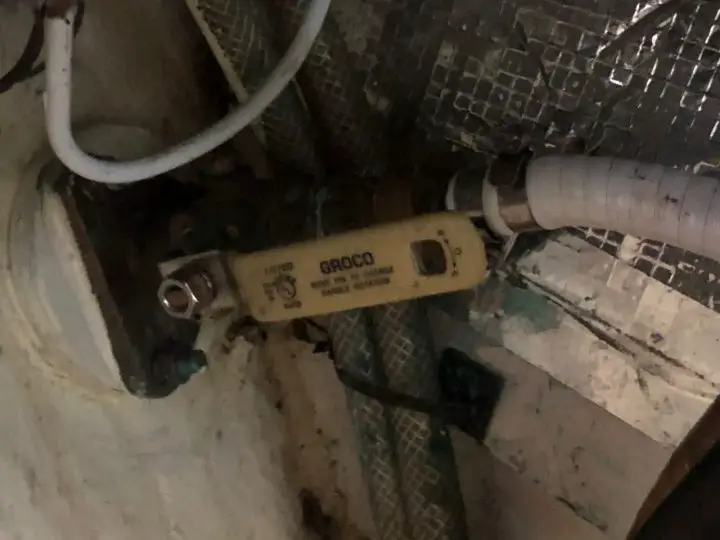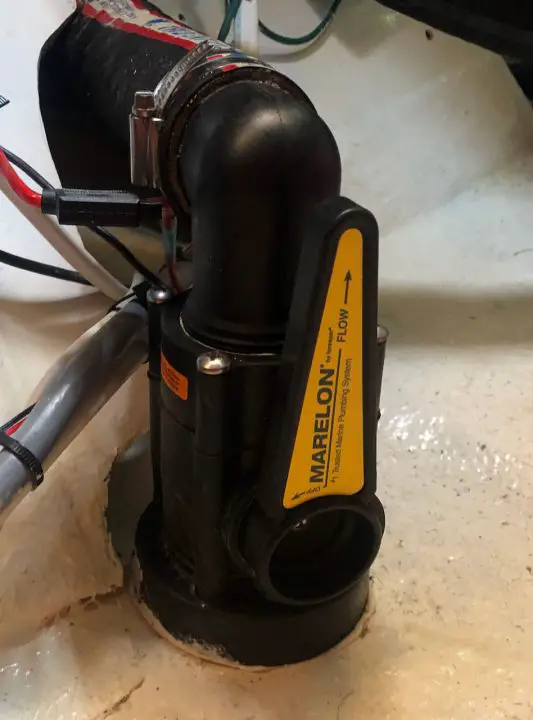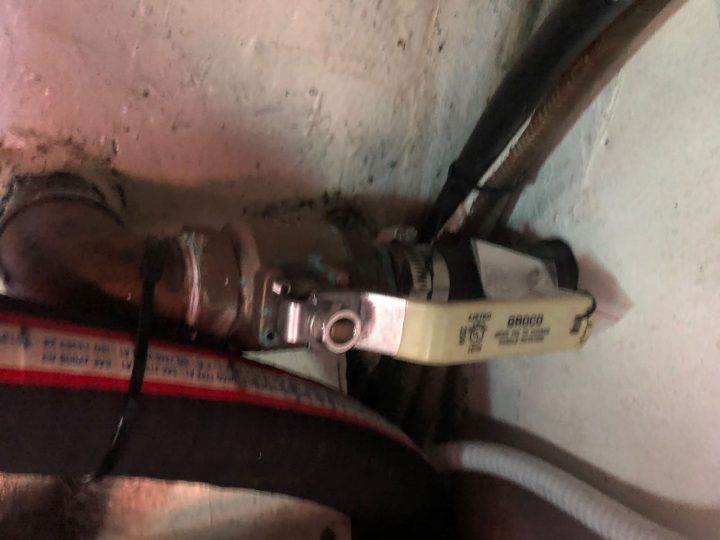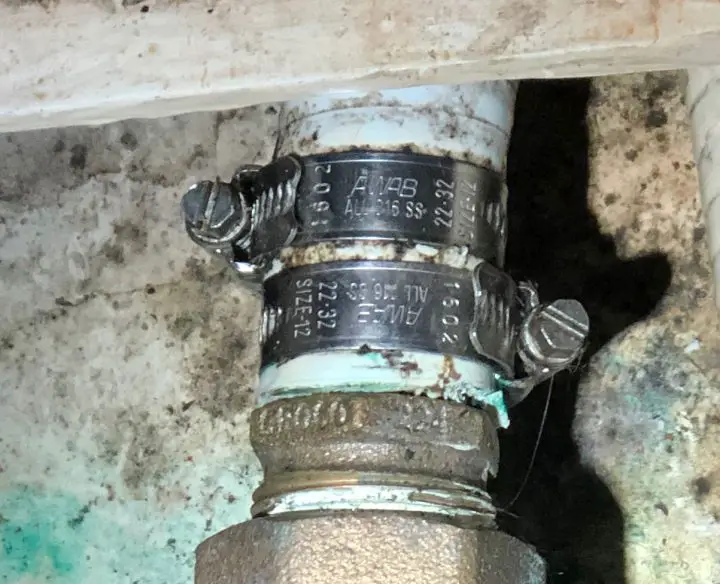Every boat has holes in it. Say what? That’s right – boats come with holes in the bottom called through hulls. In a perfect world, these would always work perfectly and never pose any issues or problems.
But this is not a perfect world – this is boating. That means that through hull problems can cause expensive issues and maybe even sink your boat. So here’s a look at these underrated and overly critical little bits in the belly of your boat.

Table of Contents
- What is a Through Hull Fitting?
- Seacock Fitting vs Through Hull Ball Valve
- Inspecting Underwater Through Hulls
- Other Through Hull Issues
- Installation Problems with Through Hulls
- Is A Seacock Fitting Done Right Worry-Free?
- Thru Hull Valves FAQs
What is a Through Hull Fitting?
Sometimes called a thru hull seacock, through hulls are, simply put, holes in your boat. They let water out or water in for drains and appliances. The fitting attaches to a hose and the hose to an appliance. The more complex the boat and her systems, the more through hulls she’s likely to have.
Through hulls are divided up between those located above the waterline and those found below it. Thru hull fittings below waterline get the most attention because a problem with these could sink your boat.
Thru Hull Fittings Above the Waterline
When a thru hull is above the water, it functions as a simple drain. If the water source is above the thru hull, as is the case in a deck drain or a sink, gravity does all of the work.
If the overboard drain is the outlet for a pump, that pump might be located anywhere. Bilge pumps usually have an above-the-water discharge.
Above waterline through hull fittings are usually simple flange or mushroom-shaped thru hulls with a hose barb attachment on the back. They literally are holes in the boat, with no way to close them. The hose is the only thing that keeps water from coming into the boat.
Since these fittings are never submerged, a broken fitting should not be a huge issue. You can easily replace them with the vessel in the water. As a result, many people use plastic fittings. The simple white nylon ones do break down in sunlight, however. The better choice is those made from reinforced plastic like Marelon.
Another great choice is a high-quality stainless steel fitting. It will last decades and is easily cleaned.
Here are just a few examples of through hull fittings found above the waterline on many vessels.
- Deck drains
- Cockpit drains
- Anchor locker drains
- Sink drains (powerboats)
- Bilge pumps
- Propane locker drains
- Bait well and fishtank drains
- Air conditioning raw water pump discharge
- Tank vents (fuel, water, and waste)
- Engine or generator exhaust
Through Hull Fittings Below Waterline
The critical thing to remember about through hull fittings that are under the waterline is that they might not be under the waterline right now—but they might be at some other time. This is the fact with sailboats, which heel while sailing. So a through hull that typically sits a foot or two above the waterline might be an underwater fitting while sailing.
This is why most sailboat sinks drain below the waterline because they need to be worked out for all points of sail.
These fittings can let water into the boat or push water out of it. If the thru hull lets water in, it is commonly attached to a strainer or simple filter to ensure nothing gets in to clog pumps. Here’s a list of the items that commonly have underwater thru hulls.
Intakes
- Engine raw water
- Air conditioner raw water
- Raw water washdown pumps
- Marine toilets
- Watermaker intakes
- Bait well and fish tank intakes
Outlets
- Sink and shower drains (sailboats)
- Toilet or holding tank waste discharge (for offshore use only)

Special Consideration for Underwater Fittings
If an underwater through hull breaks, what’s to stop water from pouring into the boat and sinking it? For that matter, if a cheap piece of hose attached to that through hull breaks, does the same happen? Of course, you have a bilge pump. But the pumps on most boats are undersized and made for dewatering rain leaks, not to save a sinking ship.
First, all underwater fittings should have a shut-off valve of some kind attached. Perhaps it is a ball valve, or the entire fitting has a valve inside it. These fancier fittings are called seacocks.
In all, most assemblies have three pieces connected together.
- Through hull skin fitting, with a mushroom or flush on the hull
- Ball valve shut off or a flange-mounted seacock
- Hose barb
The material used for through hulls is very important. There are four types of materials that you might find in underwater fittings. Assemblies should never be mixed and matched.
- Bronze fittings—the most common alloy is known as 85-5-5-5
- DZR brass—a special brass alloy with extra corrosion resistance and less zinc content
- Stainless steel—not commonly used due to crevice corrosion concerns
- Reinforced plastic (polymer composite) fittings like Marelon or TruDesign
Seacock Fitting vs Through Hull Ball Valve
If you look into the bilge of most boats, even new ones out of the factory, you will see some less-than-perfect practices when it comes to underwater fittings. The best ones are extremely expensive and costly to install. So most manufacturers find a happy medium of easy to install and cheaper.
In other words, the fittings you see on a top-of-the-line bluewater boat look very different than those you’ll find on an entry-level production boat.
Seacocks
A seacock is a special marine fitting made of the best quality bronze. It’s a one-piece item that attaches over a threaded through hull. It includes a sturdy flange assembly, so the final installation is exceptionally robust.
The best seacocks are made for a lifetime of service, with serviceable parts made to the highest standards. Needless to say, these aren’t very common due to their cost.
Through Hull Ball Valves
A much more typical installation is a through hull fitting attached with a backing nut on the hull. Screwed onto this is a ball valve to shut off water flow in an emergency.
There are a lot of problems with this setup that make it less than ideal. It is simple and relatively inexpensive, so it is the most common setup.
Even with this setup, there are best practices you can follow to get a sound installation. Just because a boat has ball valves installed doesn’t make it bad. But if it has them installed poorly or mismatched parts, it could be a disaster waiting to happen.
So underwater fittings must be made of the highest quality components that will not corrode or break. Bronze marine fittings are the industry standard and should always be used. There are different grades of bronze, and the marine-grade stuff is the most corrosion-resistant.

Inspecting Underwater Through Hulls
The first time most boaters notice trouble with their through hulls is when it becomes hard to turn the handle or has a completely seized ball valve. Whatever you do, don’t ever force a ball valve open or closed.
There are usually signs of impending trouble before you get to this point. If corrosion is the problem, your through hulls will likely begin forming a green patina. If your through hull looks nasty, it probably is.
Corrosion
The most significant danger a through hull faces is corrosion. Saltwater is corrosive, plus there can be problems with dissimilar metals, cheap materials, or stray electrical currents. All of these problems can pile up.
Dissimilar Metals
Any two metals of different types will affect one another when in direct contact. If you have a sailboat with an aluminum mast, stainless steel hardware begins causing corrosion relatively quickly. You can see the phenomenon yourself on nearly every sailboat at the marina.
The same occurs with through hulls. Many underwater fittings are made of three separate pieces, the through hull, the ball valve, and the hose barb. If one of these three pieces is stainless, corrosion will start happening pretty fast.
An even more common problem is mixing brass parts from regular hardware stores with bronze fittings from marine stores. The two metals look similar but have different compositions, so they will corrode one another over time.
Cheap Materials
The primary difference between brass and bronze is the amount of zinc in the alloy. In a corrosive environment, zinc will erode from brass fittings, leaving a fragile copper-rich alloy. This leaves the brass with a pinkish color and weakens its structure considerably.
Some boat manufacturers, looking for an alternative to expensive bronze marine fittings, have turned to installing a particular type of brass that is de-zincification resistant (DZR). It’s not bronze but rather a higher-quality type of brass that better resists corrosion.
DZR brass is still not very good, however. And other parts of the assembly are usually made with other cheap materials that can corrode quickly. On the typical through hull, you can only expect DZR fittings to last about five years or so. Proper bronze marine fittings can last decades if cared for.
This wouldn’t be a big problem except that through hulls are extremely expensive and difficult to replace. They require hauling the boat out and a lot of labor to remove and replace the old fitting and hose. It’s a simple process that takes a considerable amount of time and effort–as many boat projects do.
Stray Current
Any two metals that are submerged in the same electrolyte form a battery. Electrons begin moving from the least noble metal to the more noble, forming an electrical current. Unfortunately, boats have all sorts of underwater metals, and seawater makes a great electrolyte.
There are a few things that boat owners can do to reduce problems. Firstly, your boat should have a proper bonding system. This system connects the underwater metals to your anodes. Anodes are made of soft metals that freely break down over time—but they’re cheap and easily replaced.
Sacrificial anodes give their lives to save all the other expensive metal bits on your boat—things like your propeller, prop shaft, and through hulls. So regularly replacing your anodes is a vital bit of boat maintenance you should never ignore to prevent galvanic corrosion issues.
Stray currents come from other sources, as well. For example, if any part of your DC electrically system is not correctly grounded back to the negative terminal on the battery, that extra current can enter the bonding system of the boat. This, in turn, could break down underwater metals and is known as electrolytic corrosion.
The AC electrical system can also be a source of problems. All AC appliances on your boat should be grounded to the green wire, which in turn is grounded to the green wire in the marina’s power grid. But connecting in, you’re open to wiring problems on other boats nearby, too.
A galvanic isolator is an easy solution to this problem. This small device connects to the AC power green wire (ground or potential earth) and removes your boat from the rest of the system. It usually solves corrosion issues on your boat and is a must-have if you stay at marinas with questionable electricity or neighbors!
Other Through Hull Issues
Maintenance
Through hull assemblies, no matter what type you have, are not maintenance-free items. If you leave an underwater ball valve open or closed for years at a time, don’t be surprised when you find that it has seized.
Ball valves need to be exercised regularly. Most of them also have a grease fitting so that you can apply a bit of grease to keep it lubricated.
Breakage
The most likely cause of a catastrophic problem with your thru hull is if it breaks. This could be caused by an installation problem, but more likely some blunt trauma. Perhaps the boat impacted something outside, or perhaps something in the bilge broke the through hulls.
This is the primary selling feature of a properly installed seacock fitting. The flange and backing plate on the hull will ensure that it is more or less impossible to break the well-protected through hull fitting.
However, a long through hull with a heavy ball valve on the end is much easier to snap off. For this reason, you should always trim down any excess lengths during installation.
As a general rule, all through hulls should be sturdy enough that you can stand on them without any risk of breaking them. But, of course, that doesn’t mean that you should stand on them, just that you shouldn’t worry about anything happening if you accidentally did.
The American Boat and Yacht Council (ABYC) sets standards for proper seacock installations. H-27.6.1 says that the assembly should withstand 500 pounds of static force for 30 seconds without breaking.
Hose Problems
The next point of breakage worth considering is the hose. You should secure all underwater hoses with double hose clamps, which apply pressure in opposing directions. Proper installation of double hose clamps isn’t as straightforward as you might think.

The quality of the hose clamps is vital to consider. Those that you find at your local hardware store rust quickly. Even though they say they’re stainless, the bands are fragile, and the screw is usually steel.
A few brands made proper hose clamps for marine use. They have non-perforated bands and contain only stainless parts.
The hose itself is worth considering too. Proper hose for underwater use is expensive stuff. But it is USCG certified, double wire-reinforced, and pretty much bulletproof. Compared to the thin-walled flexible hose you’ll find for above water purposes, the difference in quality is night and day.
Installation Problems with Through Hulls
We’ve touched on a few of the problems with picking the right types of through hull fittings, but installation is far from straightforward.
Thread Compatibility
The first problem to avoid when installing your seacocks is mismatched threads. Pipe threads are commonly either NPT or NPS—tapered or straight to you and me. Purpose-built pieces for marine applications are nearly always NPS with straight threads.
The unfortunate news is that the two will seem to connect reasonably well. But if you look at a cross-section, a tapered thread in a straight hole has very poor thread engagement. It is actually dangerously weak.
Most boat manufacturers use all NPS fittings for a perfect fit. But if you come across a boat with modifications – either by DIY owners or boatyard employees, be especially wary and take nothing for granted.
Using Flanges
One of the biggest dangers facing a through hull is the possibility of it being accidentally broken off from the inside. Perhaps an unwary person stepped on it just wrong in a tight space, or perhaps they were performing maintenance with too much enthusiasm. Things happen in a boat with often the most bizarre explanations.
To ensure that a seacock can withstand any force, it needs a sturdy flange that mounts it to the hull. The flange distributes the load and forces across a greater hull section, meaning that it will not flex or crack.
The flange can be kept tight and secure to the hull with fasteners. If used, those too must be a matching bronze – or whatever alloy your seacocks are made from.
Boat Hull Backing Plates
Many boats have a relatively thin solid GRP hull, and the weight and force applied by a through hull installation may be more than it can bear alone. In these cases, a backing plate should reinforce that area of the hull.
Since they’re below the waterline, the best seacock backing plates are made of composites or another suitable material. Solid fiberglass or epoxy board, like G10, are the best solutions. Another option is marine-grade plywood. The backing block should be 1.5 times the diameter of the seacock’s flange ring and attached with excess epoxy.
Is A Seacock Fitting Done Right Worry-Free?
There are few things more unsettling for a boater than worrying about holes in the bottom of the boat. Today, through hulls are a necessary part of owning a big boat. Unfortunately, there are so many poor installations out there that we must be on guard. Unless you’re 100 percent certain about the security of your seacocks, check them right now.
Thru Hull Valves FAQs
How do you check through hull fittings?
The first step is to inspect the thru hull for any anomalies visually. Any corrosion will appear as green or white dust on the surface of the metal. If the metal is tarnished, use a wire brush to check the color of the metal. Any signs of a pink tint indicate that the metal is breaking down, a process called de-zincification.
The next thing you can do – albeit carefully – is to open and close the ball valve. It should require firm pressure but should move freely. If it is stuck, leave it alone. Never force an underwater valve because it will surely break. If it moves with no resistance at all, chances are the handle has broken, and the ball valve is seized.
This is about all that you can do while in the water to inspect an underwater through hull. If the valve is in unknown condition, remember that it might be broken and seized open. In that case, the only thing keeping the boat from taking on water is the hose attached to it.
If your through hulls are in bad shape or need servicing, it’s best to have the boat hauled out of the water for a thorough inspection.
How do through hull fittings work?
Different fittings have different jobs and are therefore designed differently. The fitting is just a hole on the hull that attaches to a hose. They can be used to drain or discharge water overboard or, if underwater, used to intake raw seawater.
Underwater through hulls must have a shut-off mechanism if the hose breaks or the hose clamps part. This shut-off is usually a simple ball valve with a valve handle that moves only 90 degrees. When the handle is parallel to the fitting, it is open. When it is perpendicular, it is closed.
The most important thing to realize about underwater fittings is that they should always be made of the highest-quality marine-grade bronze. In addition, parts of a fitting assembly should never be mixed and matched with other metals or alloys.




